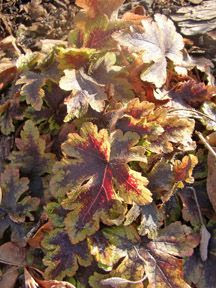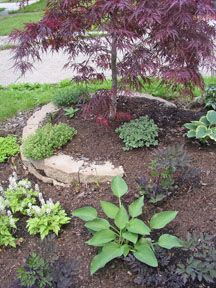 I rediscoverd tiarellas when I worked part-time at a local garden center in 2005 to help pay off my "divorce debt." The person who ordered our shade perennials had purchased a number of different cultivars, including 'Crow Feather,' 'Iron Butterfly' and 'Lacquer Leaf.'
I rediscoverd tiarellas when I worked part-time at a local garden center in 2005 to help pay off my "divorce debt." The person who ordered our shade perennials had purchased a number of different cultivars, including 'Crow Feather,' 'Iron Butterfly' and 'Lacquer Leaf.'As I occasionally deadheaded the shade perennials, I admired the tiarellas for their toughness--and their beauty of both leaf and form. When I read that they offered interesting winter color as well, I decided that I needed to bring some home with me. I liked all of the cultivars above, but for some reason was especially drawn to 'Crow Feather.'
As you can see from the first picture, 'Crow Feather' has interesting winter color. The purple blotches on the interior of the leaf turn darker purple, red, or reddish brown and the green outer leaf margins turn various shades of yellow through rust.
 In fact, winter is when I seem to appreciate tiarellas the most, but that is probably only due to lack of competition. As you can see from the other two pictures, they are pretty handsome plants in the spring when they wave bright bottlebrush flowers above their leaves. (The tiarellas are in the lower left corner of the closeup, and under the Japanese maple at the far end of the sidewalk in the other picture. In both, you can spot their white flowers.)
In fact, winter is when I seem to appreciate tiarellas the most, but that is probably only due to lack of competition. As you can see from the other two pictures, they are pretty handsome plants in the spring when they wave bright bottlebrush flowers above their leaves. (The tiarellas are in the lower left corner of the closeup, and under the Japanese maple at the far end of the sidewalk in the other picture. In both, you can spot their white flowers.) If deadheaded regularly, they continue to flower intermittently through the summer and fall. Other than deadheading, the only maintenance they need is the occasional deadleafing--similar to the treatment of heucheras. I will admit that I might be a little more vigilant about deadleafing the tiarellas, but that is only because I enjoy the scent of the leaves when they are crushed or pulled. It is very fresh-smelling, like celery and cucumber combined.
If deadheaded regularly, they continue to flower intermittently through the summer and fall. Other than deadheading, the only maintenance they need is the occasional deadleafing--similar to the treatment of heucheras. I will admit that I might be a little more vigilant about deadleafing the tiarellas, but that is only because I enjoy the scent of the leaves when they are crushed or pulled. It is very fresh-smelling, like celery and cucumber combined.My tiarellas were in their "creeping" year during 2006, so I expect to see some "leaping" out of them this year. They are even worthwhile in their slow years, however, so I hope to never be without them in the garden.
How about the rest of my fellow garden bloggers? Any quiet plants that you love and want to give a shoutout to? With plants like these, it seems that they need either a cheerleader or a publicist to make a splash... and although I've adjusted my radar, I want to make sure I'm not missing anything particularly garden-worthy.
8 comments:
I love tiarella! It was among the first plants I bought randomly at the nursery when I started gardening--long before I would have called myself a "gardener"--and it's the only plant from those days that I still have growing. I think it straddles the line between looking wild-and-native and looking gardenery. It's a little of each. I divided clumps of it last fall and it still looks kinda ragged, but two little flower stalks shot up this week
Those winter leaves are such lovely colors and I love the shape. I don't have any tiarella. In fact it's new to me. I've seen it, but didn't know the name. Thanks for educating me! I love your Japanese maple. I'd love to have one in our garden.
So sorry about your cherry tree.
Thanks for visiting. I'm glad you enjoy hearing about the cats. Do you have any of your own?
I appreciate your compliment about the storytelling too. Thanks so much :)
I haven't had luck with tiarella...maybe it's too hot here. I do have a number of heucheras, though, that might be a "quiet workhorse" and I'm trying to keep a heucherella alive. And I really like Cranesbill Biokova...spreads but it's easy to control, easy to divide, makes a nice filler and sweet spring flowers.
I don't have any tiarellas, but now that I have a few good recommendations to go on, I'll keep an eye out for them :-)
As for my "quiet workhorse," leslie beat me to the punch with heucheras, which I just love. If I had to recommend another, I'd say hostas. I know they're common, but there are so many different kinds out there, and nothing grows better on a shady northern exposure than hostas.
I do not have, or know, tiarellas. Thanks for the introduction.
I agree with you about the showstoppers. I find that I particularly like the plants that DON'T BLOOM (when they are near those that do.
I'm going out on a limb, but I planted some artemsia schmidtiana "silver mound" on a lark... and loved the result. Grey. Silver. So soft...
I loved the way it crept through things and allowed tall plants to shoot through it. There was spot where I had some blackberry lilies (belamcanda chinensis) growing up and THROUGH the artemisa. The Belamcanda is such a small lily... small flower... but POW what a show (albiet a small one). The belamcanda would have been nothing without the sea of silver.
Also, it gets tall and lush enough that it isn't really what I consider a grandcover.
I know that there are mixed reviews on artemisia but I'm a fan. (Though I can see how many people complain that it takes over. It must be cut and watched.)
Also, I noticed several leopard frogs living in it. (I'm no frog expert (nor frog enthusiast) but a neighbor, who is both, pointed them out... and it occured to me that a leopard frog is really quite beautiful too... especially in the silver.)
But I should say: I would write an ode to Artemsia... if I wrote odes.
Plus, I can't resist touching it.
There will be artemisia in every garden of mine, from now on.
And, of course, tiarelles.
(You garden looks neat as a pin. You are a busy girl.)
My "quiet workhorse" would have to be my ajuga 'chocolate chip'...it just meanders around quietly all year, providing a nice, contrasty background in my half sun/shade garden. If it goes where I don't want, light pull reins it in no problem. I find baby frogs and toads amongst the leaves a lot, too...and I'm all about providing habitat for insect-eaters!
Did you know Linnaeus himself named Heuchera a patron named Heucher, pronounced HOY-ker. So the correct pronunciation, if one cares about such things, is HOY-ker-a. I'd always said HEW-ker-a.
chuck b. I'm surprised you grow them out there! I don't know why, but I was thinking of them as an eastern/midwestern woodland plant. Thanks for the correct pronounciation of "Heuchera," too--I have always heard "HEW-ker-a" here!
kerri, I used to have two cats... one we got as a companion to the dog, the other walked into my office at work, shared half of my turkey sandwich, and obviously needed a good home. :) The cats stayed with my ex when I split, as I was taking the dog and he didn't want a completely empty house.
Leslie, I'd never seen that type of cranesbill, so I had to google it. Cute! Does the foliage get as red in the fall as the website I read claimed it does? I'm already almos sold without that, but it would be nice.
I love the heucheras, too, Colleen, but I'm just now warming up to the hostas. I don't know why, I think it was just a knee jerk reaction to hearing so many raves about them. I've recently been won over. :)
Clerk, I am totally with you on the artemisia! I think that I have 'Powis Castle' (I dug it up with permission from a garden bed when the garden center I was working at ended their lease) and I haven't found anything I don't like with it. After reading your comments about the candy lilies, I wish I'd planted some of my drumstick alliums throughout it.... *sigh* I'll keep an eye out for that ode!
Lisa, I have some of that! It was new last year so I didn't see it spread too much. So cute. I am so encouraged that you had toads in it last year--I think that my yard is too dry for them, but I would LOVE to host some!
I'm using "cute" a lot tonight. No more posting until I'm done looking at Golden Globes dresses.
Post a Comment
One of my favorite things about blogging is the interaction--posts are often simply the beginning of an interesting conversation! So thanks for taking the time to join the discussion, and please know that I enjoy reading each and every comment left here. I try to answer as many as I can.